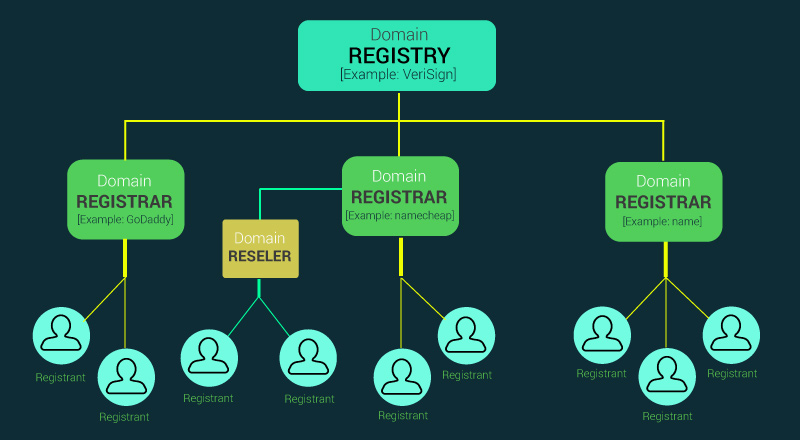Domain registration and management involves multiple parties with different roles, like Registry, Registrar, Reseller & Registrant (Domain Name Hierarchy). On top of those 3, there’s also ICANN (Internet Corporation for Assigned Names and Numbers). We’ll quickly cover all these roles.
ICANN
ICANN is non-profit entity comprised of individuals, government, law enforcement, intellectual property law and private business. This entity oversee and impose rules and regulations. ICANN draws up contracts with each registry and it also runs an accreditation system for registrars. When it comes to IP addresses, ICANN doesn’t run the system, but it does help co-ordinate how IP addresses are supplied. It’s also the central repository for IP addresses, from which ranges are supplied to regional registries who in turn distribute them to network providers.
Registry
Registry is an organization that manages top level domain names (at the top of the Domain Name Hierarchy). Most registries operate on the top-level and second-level of the DNS. A registry operator, sometimes called a network information center (NIC) maintains all administrative data of the domain and generates a zone file which contains the addresses of the nameservers for each domain.
Each registry is an organization that manages the registration of domain names within the domains for which it is responsible, controls the policies of domain name allocation, and technically operates its domain. It may also fulfill the function of a domain name registrar, or may delegate that function to other entities
IANA delegates all other domain name authority to other domain name registries.
Country code top-level domains (ccTLD) are delegated by IANA to national registries such as DENIC in Germany and Nominet in the United Kingdom.
Registry Examples:
- VeriSign
- IANA
- Denic
- Nominet

Registrar
Registrar is an accredited organization (e.g. by ICANN) that sells domain names to the public (registrants, like you). A domain name registrar must be accredited by a generic top-level domain (gTLD) registry or a country code top-level domain (ccTLD) registry. It operates in accordance with the guidelines of the designated domain name registries.
Registrar Examples:
- namecheap
- GoDaddy
- name

Reseller
Resellers are mostly companies that sell domains directly to registrants through some cooperation/affiliate program with other registrars. Frequently they offer additional services like hosting and/or website building.
Registrant
Registrant is a person or organization who registers a domain name. Changes made on the domain, registarar will send to registry, but now always. For instance, when it comes to WHOIS data, it can be updated on registrar (fat whois – full info) or on registry (thin whois – basic info). In the past, updates to fat whois on registrar frequently didn’t propagate to registry (either fast enough, or at all). Verisign support for instance claimed that the out-of-sync situation between fat and thin whois is normal. Registrar should send updates to registry, but sometimes they don’t.
Conclusion
This is a short overview of the Domain Name Hierarchy. When it comes to rules, it’s a mess, they’re not always strictly followed. Registrars are obligated to send updates to registries but sometimes they don’t (out of sync fat/thin whois data), registrars/registries should be fined by ICANN if they break some general game rules but that doesn’t happen (in cases where whois is not provided, abuse address reporting, etc.).
GDPR made additional chaos, WHOIS data is redacted, unavailable with no alternatives in sight yet. The RDDS/RDAP is WHOIS successor, but not yet ready/available on all registrars. The ccTLD domains are even worse. Each country has its own rules, limits and conditions. All that is entirely different story…







